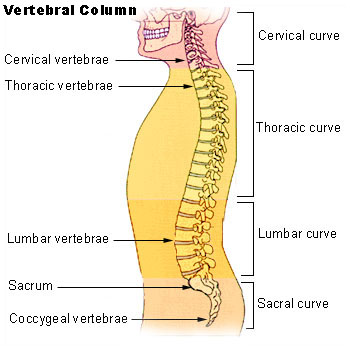What IS Lordosis?
Lordosis refers to the inward curve of the spine. Both the lumbar and cervical regions of the spine have “lordotic” curves. It can also be referred to as “extension” of the curve.
How much lordosis is normal?
According to orthopedic physical therapy text books, the normal curve in the lumbar spine should be approx. 30-35 degrees while standing during postural evaluation.
Reduced curves in the lumbar spine can cause increased pressure on discs, which too much lordosis increases pressure on the facet joints in the spine.
Lordosis and Pelvic Tilt: The Link To Back Pain
The degree of tilt in the pelvis has a direct influence on the curvature of the spine. If you imagine your pelvis as a bucket of water, and it was tipped forward so that you were pouring water on your toes, this would be referred to as anterior pelvic tilt. This tilt is correlated with an increase in lumbar spine lordosis. The opposite tilt, called posterior pelvic tilt, reduces the lordosis in the spine.
How To Correct Excessive Spinal Lordosis
The correction protocol for too much lumbar lordosis first starts with understanding which muscles can affect this position. Since excessive anterior pelvic tilt is directly correlated with increased lordosis, the same muscles must be addressed. Lordosis exercises must be selected based on the muscle imbalances present.
The lordotic curve itself is created by the tension in the lumbar spine extensors as well as the quadratus lumborum. The rest of the muscles that need to be addressed are the ones I talk about with excessive anterior pelvic tilt. They include:
- Psoas Major
- Iliacus
- Rectus Femoris
- Tensor Fascia Latae
- Calves
The muscles listed above are all frequent contributors to excessive anterior pelvic tilt, which, as discussed, increases the lumbar curve. Stretching these muscles will allow for a reduction in pelvic tilt, and therefore lumbar lordosis. Here is an example of how to stretch the hip flexor muscles that contribute to excess lordosis:
The weaknesses which are present that allow for increased lumbar lordosis include:
- Glutes
- Hamstrings
- Abdominals
- Obliques
The muscles listed above can either be weak and de-conditioned, or simply inhibited due to excess tension in the tight muscles. For example, when the hip flexors such as the psoas is tight, its opposing muscle which is the glute maximus, will be weakened. This is due to a neurological law called Reciprocal Inhibition. Put simply, if for example you contract your bicep muscle, then your tricep muscle must to some degree lengthen to allow for the bicep contraction.
The TOP Lordosis Exercise
If I were to choose one exercise that I use very consistently for correction of excess lumbar lordosis, it would be the Reverse Hyperextension. The Kneeling Hip Flexor stretch, which is in the video above, is VERY useful, but will not address the glute weakness. Most often both of these movements must be used to get the desired result. Watch the video below:
This movement is highly productive, but must be used sparingly, especially considering how much back pain is present. I use it only after my initial corrective exercise protocol for addressing the basic muscle imbalances associated to back pain.

